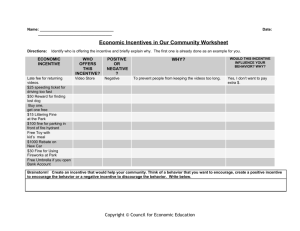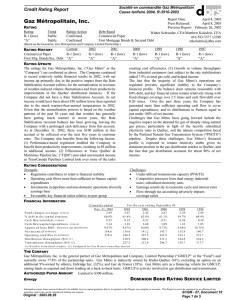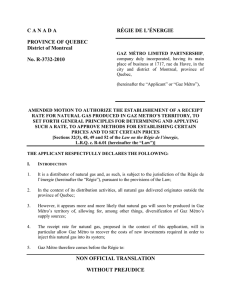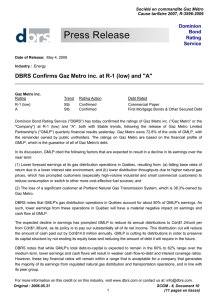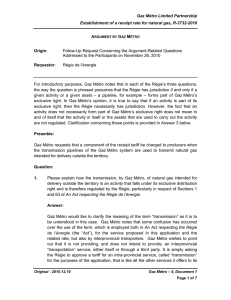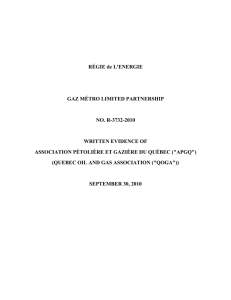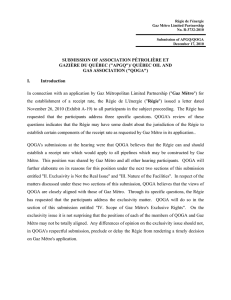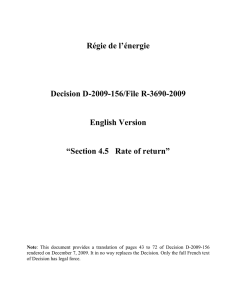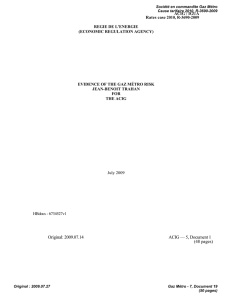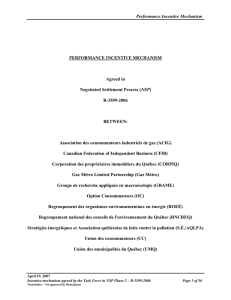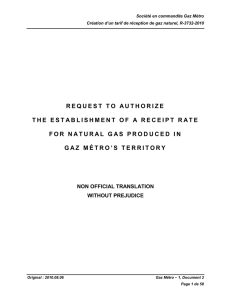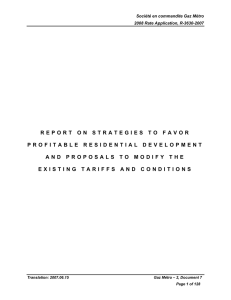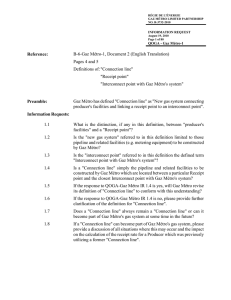R-3693-2009 Le 11 novembre 2011
advertisement
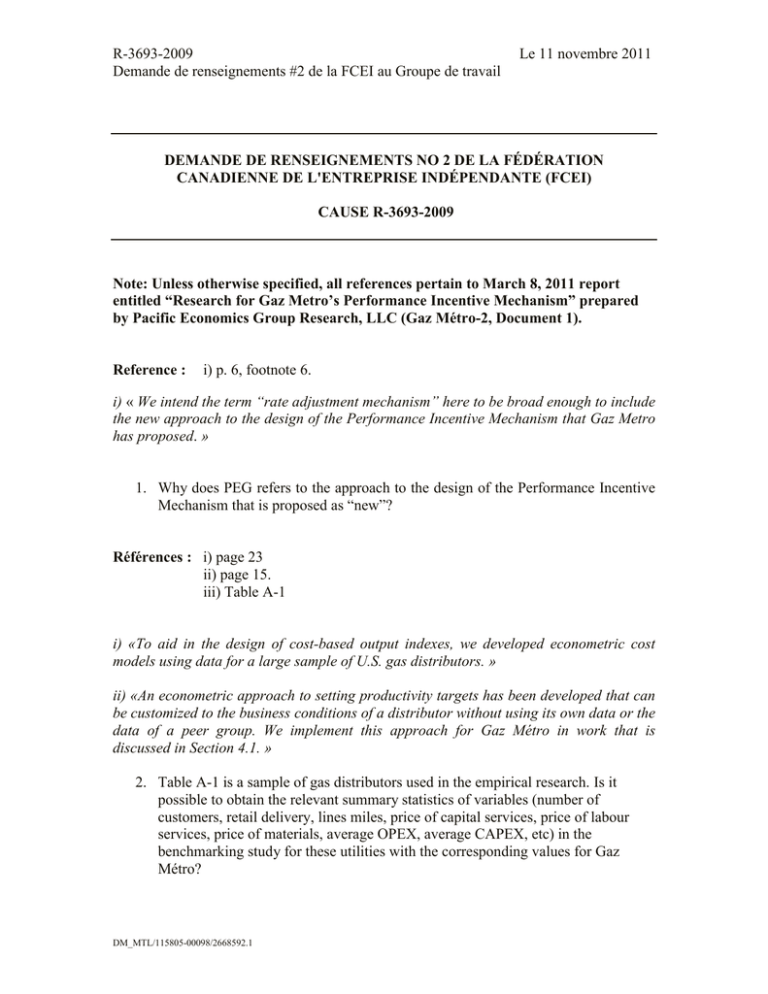
R-3693-2009 Demande de renseignements #2 de la FCEI au Groupe de travail Le 11 novembre 2011 DEMANDE DE RENSEIGNEMENTS NO 2 DE LA FÉDÉRATION CANADIENNE DE L'ENTREPRISE INDÉPENDANTE (FCEI) CAUSE R-3693-2009 Note: Unless otherwise specified, all references pertain to March 8, 2011 report entitled “Research for Gaz Metro’s Performance Incentive Mechanism” prepared by Pacific Economics Group Research, LLC (Gaz Métro-2, Document 1). Reference : i) p. 6, footnote 6. i) « We intend the term “rate adjustment mechanism” here to be broad enough to include the new approach to the design of the Performance Incentive Mechanism that Gaz Metro has proposed. » 1. Why does PEG refers to the approach to the design of the Performance Incentive Mechanism that is proposed as “new”? Références : i) page 23 ii) page 15. iii) Table A-1 i) «To aid in the design of cost-based output indexes, we developed econometric cost models using data for a large sample of U.S. gas distributors. » ii) «An econometric approach to setting productivity targets has been developed that can be customized to the business conditions of a distributor without using its own data or the data of a peer group. We implement this approach for Gaz Métro in work that is discussed in Section 4.1. » 2. Table A-1 is a sample of gas distributors used in the empirical research. Is it possible to obtain the relevant summary statistics of variables (number of customers, retail delivery, lines miles, price of capital services, price of labour services, price of materials, average OPEX, average CAPEX, etc) in the benchmarking study for these utilities with the corresponding values for Gaz Métro? DM_MTL/115805-00098/2668592.1 R-3693-2009 Demande de renseignements #2 de la FCEI au Groupe de travail Le 11 novembre 2011 3. From reference ii), should the reader posit that even if Gaz Metro’s variables are different from the average variables of the sample, Gaz Metro’s productivity targets will still be relevant? Reference: i) Table 1 4. Please confirm that elasticity weights were derived from the same econometrical work as presented in appendix A.3. Please explain the rationale underlying footnote 27. 5. Please provide the elasticities that underlie the Elasticity Weights (and the calculation of those elasticities). References: i) Tables 2 and 3 ii) Gaz Métro-1, Document 2, section 3.3.1. It is FCEI’s understanding that the definition of the O&M cost data used by PEG to compute the O&M productivity is different than the definition of the O&M cost data defined under section 3.3.1 of the proposed incentive mechanism. 6. Please compute the O&M productivity using the data provided in answer to question 2 directed at the Groupe de travail by the FCEI. References: i) p.30 ii) Tables 6 and 7 i) “The volatility makes the output differential unusually sensitive to the choice of sample period. Our preliminary judgment is that the 0.27% annual growth rate in total throughput for the 2000-2007 period is more representative of the long run trend in the service territory. The difference between 0.27% and the 1.93% growth trend of the elasticity-weighted output quantity index for the same period is -1.65%. The difficulty of choosing an appropriate sample period for the calculation of an output differential is a disadvantage of Gaz Metro’s current approach to revenue cap design.” (p.30) 7. Would you, please, elaborate on the underlined sentence? 8. Please indicate if volumes used in the output differential calculation were revenue weighted (in fact price weighted). If not, please reconcile with formulas [5] and [13] on pages 8 and 12 of the report. Why aren’t contract demand and number of customers considered in the output differential calculation? 9. If possible, comment on output differential volatility once volumes are weighted. How does weighting the volumes affect the statement below? DM_MTL/115805-00098/2668592.1 R-3693-2009 Demande de renseignements #2 de la FCEI au Groupe de travail Le 11 novembre 2011 10. The output differential is calculated on the basis of the total throughput which includes declining volumes in small customers. The current incentive mechanism includes a factor that compensates Gaz Métro for the declining volumes in small customers (exogène “variation de volumes”). If the output differential derived in table 6 was applied to the current incentive mechanism, is it correct that Gaz Métro would be compensated twice for the same declining volume phenomenon? If so, would eliminating the exogenous factor “variation de volumes” and using a productivity measure that accounts for the output differential computed as per formulas [5] and [13] fix the double counting issue? Reference: i) Table 10 11. How does Gaz Métro compare to the companies included in the US sample (with respect to its operating scale, business conditions, input prices, pace of output growth, average OPEX, average CAPEX, rate base, etc.)? 12. Please provide the weighted average OPEX and CAPEX per customer from the US sample (weighted by the number of customers). 13. Based on GM’s average OPEX (737$/customer) and CAPEX (634$/ customer) and the elasticity factor found in PEG’s study for OPEX (0.8) and CAPEX (0.95), is it correct that the implied marginal cost of adding a new customer would be 590$ and 602$ for OPEX and CAPEX respectively? If not, please indicate what the implied marginal costs would be. Please compare those values with the actual US marginal cost and comment on the differences. Please compare those values with the marginal cost used by Gaz Métro to assess the profitability of its customer additions and comment on the differences? 14. Please confirm that the Forward Productivity Growth Target calculation assumes that, at “expected” growth rate, all economies of scale would be returned to the clients through the productivity factor. Please explain the rational for this. 15. Please confirm that the Forward Productivity Growth Target calculation assumes that, at “above than expected” growth rate, some economies of scale would be share between the clients and Gaz Métro. Please explain the rational for this. 16. Please confirm that the Forward Productivity Growth Target calculation assumes that, at “below than expected” growth rate, more economies of scale would be returned to customer than that amount actually realized. Please explain the rational for this. Référence : i) p. 45 i) “All things considered, the indicated range of potential stretch factors when the X DM_MTL/115805-00098/2668592.1 R-3693-2009 Demande de renseignements #2 de la FCEI au Groupe de travail Le 11 novembre 2011 factor is based on our forward looking external productivity growth projections is [0.20, 0.50]. If the Company’s own historical productivity growth trend is used to set X, our research indicates no need for a stretch factor if there is symmetrical 50/50 sharing since the new Performance Incentive Mechanism would have the same incentive power as the old mechanism.” 17. Please confirm that your conclusion that the Performance Incentive Mechanism would have the same incentive power as the old mechanism is based on the fact that both mechanisms have a symmetrical 50/50 sharing. 18. Anything else being equal, would the Performance Incentive Mechanism still have the same incentive power as the old mechanism if the stretch factor was set to any value in the 0.20-0.50 range? Please explain. 19. Please indicate if the new Performance incentive mechanism that you were referring to at the time of preparing your report is the same as the one filed as of August 29, 2011. If not, please indicate if the modifications have an impact on any of your recommendations and how. DM_MTL/115805-00098/2668592.1





